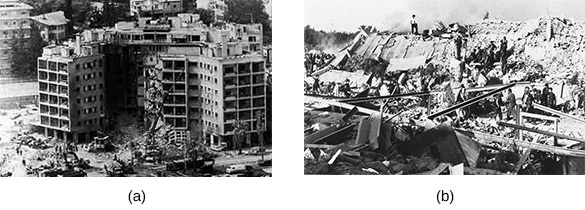| << Chapter < Page | Chapter >> Page > |
In addition to reviving the economy and reducing the size of the federal government, Ronald Reagan also wished to restore American stature in the world. He entered the White House a “cold warrior” and referred to the Soviet Union in a 1983 speech as an “evil empire.” Dedicated to upholding even authoritarian governments in foreign countries to keep them safe from Soviet influence, he was also desperate to put to rest Vietnam Syndrome , the reluctance to use military force in foreign countries for fear of embarrassing defeat, which had influenced U.S. foreign policy since the mid-1970s.
Reagan’s desire to demonstrate U.S. readiness to use military force abroad sometimes had tragic consequences. In 1983, he sent soldiers to Lebanon as part of a multinational force trying to restore order following an Israeli invasion the year before. On October 23, more than two hundred troops were killed in a barracks bombing in Beirut carried out by Iranian-trained militants known as Hezbollah ( [link] ). In February 1984, Reagan announced that, given intensified fighting, U.S. troops were being withdrawn.

Two days after the bombing in Beirut, Reagan and Secretary of State George P. Shultz authorized the invasion of Grenada, a small Caribbean island nation, in an attempt to oust a Communist military junta that had overthrown a moderate regime. Communist Cuba already had troops and technical aid workers stationed on the island and were willing to defend the new regime, but the United States swiftly took command of the situation, and the Cuban soldiers surrendered after two days.
Reagan’s intervention in Grenada was intended to send a message to Marxists in Central America. Meanwhile, however, decades of political repression and economic corruption by certain Latin American governments, sometimes generously supported by U.S. foreign aid, had sown deep seeds of revolutionary discontent. In El Salvador, a 1979 civil-military coup had put a military junta in power that was engaged in a civil war against left-leaning guerillas when Reagan took office. His administration supported the right-wing government, which used death squads to silence dissent.
Neighboring Nicaragua was also governed by a largely Marxist-inspired group, the Sandinistas. This organization, led by Daniel Ortega, had overthrown the brutal, right-wing dictatorship of Anastasio Somoza in 1979. Reagan, however, overlooked the legitimate complaints of the Sandinistas and believed that their rule opened the region to Cuban and Soviet influence. A year into his presidency, convinced it was folly to allow the expansion of Soviet and Communist influence in Latin America, he authorized the Central Intelligence Agency (CIA) to equip and train a group of anti-Sandinista Nicaraguans known as the Contras ( contrarevolucionários or “counter-revolutionaries”) to oust Ortega.

Notification Switch
Would you like to follow the 'U.s. history' conversation and receive update notifications?